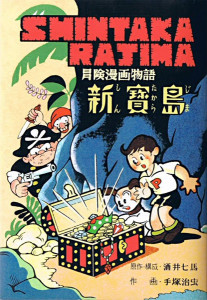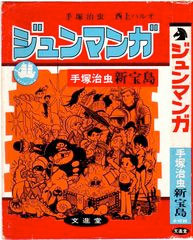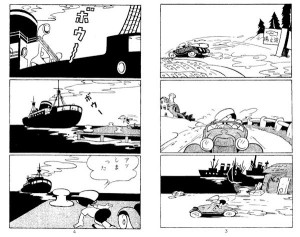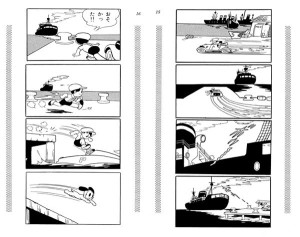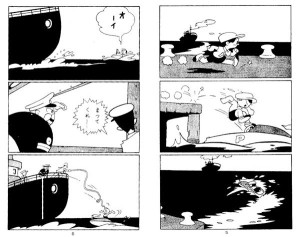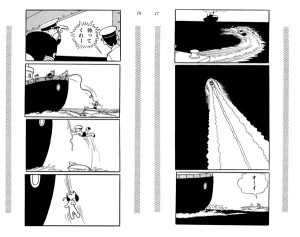New Treasure Island (Manga)
Also known as 新寳島 (Shin Takarajima)
| English Title: | New Treasure Island |
| In English? | Yes [digital] |
| Japanese Title: | 新寳島 Shin Takarajima |
| Type: | Book |
| Original run: | 1947/01 |
| Published by: | Ikuei |
| Volumes: | 1 MT-281 |
New Treasure Island (1947) is, by and large, considered Osamu Tezuka’s debut work. It was first published in January 1947, when Tezuka was still a 19 year-old medical student, and although it was preceded by the “gag manga” strip, The Diary of Ma-chan (1946), it is Tezuka’s first long-form “story manga”.
What it’s about
With the map left by his father as his clue, Pete jumps in his car and zooms down to the docks – very nearly running over a stray dog in the process. Luckily the dog is unhurt and the pair board a departing ship just in the nick of time. Convincing the ship’s captain to join him on a treasure hunt, they are quickly beset by marauding pirates lead by the terrible, one-arm and one-leg pirate captain named Boar. Although they are captured by the pirates, the tossing waves loosen Pete’s ropes and they escape overboard, adrift on a makeshift raft.
Despite all the odds against them, Pete, Captain and Doggie land on just the island they were searching for all along and set off in search of the treasure. Pursued by the pirates, they escape with the assistance of a Tarzan-like white man named Baron. With the help of their newfound friend, the heroes get the treasure, and the pirates get what’s coming to them.
After being rescued from the island by a passing freighter, Pete, Captain, Doggy, Baron and a menagerie of island animals all set off for home – dreaming of what they’ll do with the treasure once they get back to civilization. However, that night, Doggy reveals to Pete that he is, in fact, not a dog but a fairy named Pan and that the adventure was all a wish-fulfillment dream.
In the morning, Pete awakes to find that he is the only one with any memory of the adventure. He may not have the treasure, but he certainly has a tale to tell.
What you should know
Quite obviously, despite the title, New Treasure Island (1947) is not a retelling of Robert Louis Stevenson’s 1883 classic novel, Treasure Island. In fact, besides the fact that there’s an island, some treasure, a boy and a pirate, there’s very little to connect the two at all.
Published very early in his career, Tezuka was asked to do the story based on a concept provided b another local (and at the time more established) manga artist in Osaka, named Shichima Sakai. A prolific workhorse – even in those early days – Tezuka’s original draft was nearly 250 pages long. However, since Sakai had promised the publishing company Ikueisha only 190 pages, so he cut roughly 60 pages from the manuscript, changing much of the script and retouching the artwork as he saw fit along the way. In the end, despite the need for the pages to be laid out a certain way for publication, the rearranged story was weakened, with some plot elements shifted around or removed entirely.
Furthermore, much of the new connecting dialogue was simplified because Sakai felt some sequences would be to complicated to understand for the young readers. However, even with these drastic changes to Tezuka’s original vision, New Treasure Island (1947) was an almost overnight sensation, quickly selling over 400,000 copies (a significant feat in a Japan still recovering from the ravages of the Second World War). It introduced Tezuka’s cinematic storytelling techniques to the manga-buying public, cementing Tezuka’s status as a manga star, and arguably starting the entire story manga genre in Japan.
Although New Treasure Island (1947) was a huge success, because the revisions to his original draft had been made without consulting him, the resulting work was something that Tezuka felt he could not truly call his own. As such Tezuka never granted permission for the work to be reprinted. Yet among his many fans, it was widely-recognized as “Osamu Tezuka’s debut work” and the longer it remained out of print, the greater its legend grew – eventually gaining an almost mythical status, with original editions commanding a price-tag to match.
So great was the demand to see this work in print, that circa 1968 Susumu Hall decided to publish an unauthorized edition of New Treasure Island (1947) in Jun Manga vol. 1 (a vol. 2 was never subsequently published). Without access to the original printing plates, the artwork was manually traced by Haruo Nishigami and it was released under the banner of a “Manga Research Series” – it was basically an amateur dōjinshi.
The situation finally came to a head in the late 1970’s/mid-1980’s though, when Kodansha began publishing the Osamu Tezuka Complete Manga Works edition (1977-1997). Well-known as Osamu Tezuka’s debut work, how could it not be included in a complete works edition? Indeed Kodansha’s original marketing campaign for the series had touted it as including everything “from New Treasure Island to the latest work!” Yet Tezuka remained reluctant to include it for several reasons.
On the one hand, since the original manuscript was no longer available (having been the property of Ikueisha and been lost over the years), reprinting those crude drawings from secondary sources would be difficult to bear. Also, because of Sakai’s harsh editing he felt he couldn’t really lay claim to the work. Yet, what was possibly the biggest reason for his reluctance, was that the Osamu Tezuka Complete Manga Works editions were intended to reach a new, “modern-day” audience and he was concerned that what had been new and fresh in 1947 would look extremely dated and tired in 1984.
As was so very typical of Tezuka, he didn’t want to damage the fond, nostalgic, view the public (most of whom had never seen it) held for New Treasure Island (1947) by presenting them with the cold, harsh reality. And so, in order to solve the problem, Tezuka did the only thing he could think of, he redrew the entire thing – from memory.
The work included in the Osamu Tezuka Complete Manga Works edition (MT-281) is much closer to Tezuka’s original vision of the story. The two biggest differences, plot-wise, is that the “Peter Pan” type character of the Puppy was reinstated (having been rendered vague, unimportant and ultimately cut by Sakai’s edits in the original). The second is that Tezuka re-established the “it was all just a dream” ending that he had always wanted. Stylistically it is best categorized as Tezuka attempting to recapture his early style – but with his experienced sensibilities. Although drawn relatively simplistically, the lines are extremely clean and purposeful. However the largest change is in the layout. Often lauded as the beginning of Tezuka’s ground-breaking cinematic style, in the 1984 remake Tezuka cranks up the tempo even higher. In the original Ikueisha version, the layout is established in a three-panel page, however the Kodansha version is laid out with four panels. As a result the story develops faster, and at a higher tempo.
Although the Kodansha edition may have placated fans wanting to see Tezuka’s famous first work, and calmed Tezuka’s worries about it being published, no serious academic reflection on the works of such an important figure to manga as Osamu Tezuka can ignore his earliest work. As such, after nearly fifty years, Tezuka Productions finally agreed to reprint the original version of New Treasure Island (1947) in 2009. Published as part of the Osamu Tezuka 80th anniversary celebrations, the archival-quality slipcase edition reprints, in its entirety, the original 1947 version of New Treasure Island (1947).
Finally, it’s also worth noting that, strangely enough, the New Treasure Island (1947) manga is not the basis of Tezuka’s later New Treasure Island TV Special.

